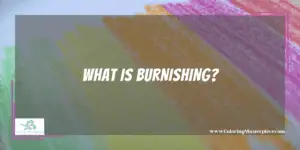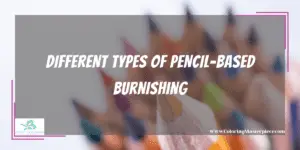As a versatile medium, colored pencils can go from simple letter art to high-end portraits, dynamic cartoons, and deep skyscapes. One such tool and technique to achieve the painter-like quality in colored pencils is by using a burnishing pencil. A burnishing pencil uses a colorless wax binder to further saturate colors and smoothen out textures.
To use a burnishing pencil, begin with a single layer of any colored pencil lightly covering the area. Next, apply a burnishing pencil over the colored area slowly increasing the pressure as you color. Though it looks like you’re coloring over the first layer of color, you’re pressing the pigment of the color into the fine grains of the paper using the burnishing pencil to bind the two together producing a more saturated visual and shining finish.
What is Burnishing?

Burnishing is layering colored pencils into blends until no paper grain shows through the colored areas by working the color and the binder of the color into the tooth of the paper. This technique works best with a wax-based binder such as a much-favored Prismacolor Premier pencil.
To achieve this, the general rule is, to begin with, light areas first, with a light coat of color using minimum pressure. Next, blend darker layers of color into the lighter base coat gradually increasing the pressure in your drawing hand. By working layers of color — either similar or dissimilar — into one another, a saturated color effect can be produced.
Lastly, take the burnishing pencil and work it into the paper starting with light pressure and graduating to more intense pressure over time. The burnishing pencil is excellent at smoothening out the surface of the paper working the layers of colors into the tooth and creating a finishing sheen over the surface of the picture.
What is a Burnishing Pencil?
A burnishing pencil, similar to a colorless binder pencil, is typically a wax-bound colorless colored pencil. This means that the colored pencil pigment contains the same wax-based binder that all other colored pencils contain, however, the pigment in a colorless colored pencil is either clear, transparent, or most commonly, non-existent.
White-colored pencils and grey-colored pencils can also be used as pencil-based specific burnishing pencils and are more commonly used in greyscale palette pictures. purposes usually associated with saturation burnishing or tonal burnishing. Frequently colorists will simply use the same colored pencil in two layers, or two colors burnished together for blending purposes.
How To Use A Burnishing Pencil
- The base layer of color begins with a lightly colored area of any given color. Cover as much of the paper grain in the swatch area as possible without formally pressing down into the paper.
- Hand Technique ovals are recommended for the best texture results, however, countless artists use cross-hatching to great effect, just so long as you’re not madly scribbling in no one particular direction.
- The Burnishing Layer turns on the pressure a little using either the specific burnishing pencil, a secondary colored pencil, or even the same base-layer colored pencil. Be wary of using too much pressure, chipping the pencil, or cramping your hand isn’t necessary to make this work, but put a little muscle into the color.
Feel free to take as long as you need to work the pencil’s pigment into the paper where the lighter base layer of color lies. You want the saturation of the color to sink into the tooth or grain of the page. That is burnishing!
- Hand Technique again, no crazy pressure, and lean towards ovals or cross-hatching. When it comes to the burnishing pencil, get creative with what side of the pencil you’re going to use. Rotate around the side of the pencil, and even use the tip directly down in finer situations.
- Visual Cues the first cue that you’re successfully burnishing is a visible smoothing of texture. Once you begin to see the wax gloss over the colors you’re in the right spot, continue burnishing and you’ll soon see a sheening texture. Additionally, the colors may pop with more saturation behind them.
Streaking marks in the layers are a clear sign of too much pressure being added too soon in the swatch or color area. On the flip side, if the colors aren’t layered with enough pressure or time, the picture’s colors will appear muted.
- Layering can’t stress it enough, start light then apply more pressure with the pencil as you layer, and take your time.
Different Types of Pencil-Based Burnishing

- Basic Burnishing is done by beginning with a light base layer of color, then using the same colored pencil, and color on top of the lighter coat increasing the amount of pressure applied. Keep in mind you should never use so much pressure that the pencil tip chips or breaks, or your hand begins to cramp and ache from too much force.
- Basic Burnishing With A Burnishing Pencil is the same process as Basic Burnishing except after the last layer of color is coated on the area, use the burnishing pencil to smoothen out the texture and further saturate the color.
The burnishing pencil is also exceptional for blending colors into each other creating a smooth gradient. Instead of blending layers of the pencil over one another, color two different areas of color next to each other with a border area where each color mixes a little. Next, take the burnishing pencil and work it into the mixed color area and little past in each direction — this technique is referred to as merging colors or merging neighboring colors. Typically the colors will smoothen out into each other and a waxy sheen may build up over the top of the picture.
The burnishing pencil can even be used over the top on one very saturated layer of lighter color to ensure little to no white grain peaks through while not having to darken the lightest swatch in the picture. A similar effect can be achieved with the darkest swatch on the paper with a thick single saturated layer of the darkest color value and a layer of burnishing pencil over it, thus preserving and emboldening the heavily saturated tone.
- Saturation Burnishing is a more niche area of burnishing geared toward portraits because of the neutral tone basis behind the technique. Saturation Burnishing requires neutral and skin tone colors only in combination with a burnishing pencil. Tones of grey, brown, peach, and black-and-white are the primary color palettes used in saturation burnishing. The wider variation achieved and more diverse temperature of color values available in skin tones due to the saturated pigment build-up make this particular burnishing technique so great for portraits.
For instance, starting with light base layers of sepia, khaki, and Sienna then coloring heavier layers over creates a rich skin tone canvas for the burnishing pencil to embolden. Lastly using the burnishing pencil to bind the pigment and wax further into the paper, the picture presents a deep and illustrious skin tone.
- Tonal Burnishing is similar to saturation burnishing where an analogous color palette is used, however tonal burnishing works outside the confines of neutral or skin tone palettes. Instead, tonal burnishing typically draws from blue tones, green tones, orange tones, purple tones, red tones, or just about any color in between. making this technique great for landscapes and scenery like skyscrapers, forests, sunrises, sunsets, or even spring gardens.
Use analogous colors from light to dark, and a burnishing pencil at the end to achieve a deeper variation of tonal temperatures. For instance, clear skies in spring are more than just one light blue. Applying tonal burnishing, color something like cadet blue, celeste, and sky blue laying the lighter coats first. Then work heavier coats of color into each other by merging the colors. Lastly, layer a blend of burnishing pencils over key areas or even the whole picture for a vibrant and deep sky.
Learn more about burnishing HERE.
Frequently Asked Questions
What’s The Difference Between Using a Burnishing Pencil vs A Blending Solvent?
Where both tools are adept at further saturating the pigment of colored pencils, they differ by texture in the results. Due to the waxy nature of a burnishing or binding pencil, the texture is smooth with a silky shine. On the other hand, since a blending solvent is liquid-based, the texture becomes more opaque and watery without diluting the color. As far as which one is better… ultimately it’s up to you the colorist to decide which tools best create your vision.
What Are Some Recommended Burnishing Pencils?
Honestly, you can’t go wrong with the Prismacolor Primer Colorless Blender available at Staples, Blick Art Materials, or Joann’s. Derwent also makes a burnishing pencil well worthy of any colorist’s time and is easily found at similar stores including Micheals, or Jerry’s Artarama.
Maximize the benefits of coloring with my free adult coloring eBook and by signing up for my email newsletter HERE!
Disclaimer: The information provided by ColoringMasterpiece.com (“The Site”) is for general informational purposes only. All information on the Site is provided in good faith, however, we make no representation or warranty of any kind, express or implied, regarding the accuracy, adequacy, validity, reliability, availability, or completeness of any information on the Site. Under no circumstance shall we have any liability to you for any loss or damage of any kind incurred as a result of the use of the Site or Reliance on any information provided on the Site. Your use of the Site and your reliance on any information on the Site is solely at your own risk. This blog post is for educational purposes only and does not constitute legal advice. Please consult a legal expert to address your specific needs.
Terms and Conditions: https://coloringmasterpiece.com/terms-and-conditions/

